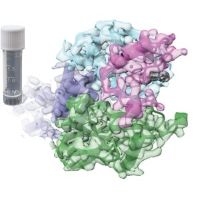Specification
| Description | Recombinant protein from the full-length sequence of homo sapiens regulatory associated protein of MTOR complex 1 (RPTOR), transcript variant 1 (NM_020761). |
| Organism | Homo sapiens (Human) |
| Expression Host | Human Cells |
| Tag Info | His or DYKDDDDK. Please contact us if you need further information or require specific designed tag. |
| Purity | Greater than 90% by SDS-PAGE gel |
| Uniprot ID | Q8N122 |
| Entry Name | RPTOR_HUMAN |
| Gene Names | RPTOR KIAA1303 RAPTOR |
| Alternative Gene Names | KIAA1303 RAPTOR |
| Alternative Protein Names | Regulatory-associated protein of mTOR (Raptor) (p150 target of rapamycin (TOR)-scaffold protein) |
| Application | Antigens, Western, ELISA and other in vitro binding or in vivo functional assays, and protein-protein interaction studies; For research & development use only! |
| Buffer | Purified protein formulated in a sterile solution of PBS buffer, pH7.2, without any preservatives |
| Endotoxin | Endotoxin level is < 0.1 ng/µg of protein (<1EU /µg) |
| Length | 1335 |
| Molecular Weight(Da) | 149038 |
| Protein Sequence | (The sequence of expressed protein may have some variation from the sequence shown below. Please contact us for the exact sequence.) MESEMLQSPLLGLGEEDEADLTDWNLPLAFMKKRHCEKIEGSKSLAQSWRMKDRMKTVSVALVLCLNVGVDPPDVVKTTPCARLECWIDPLSMGPQKALETIGANLQKQYENWQPRARYKQSLDPTVDEVKKLCTSLRRNAKEERVLFHYNGHGVPRPTVNGEVWVFNKNYTQYIPLSIYDLQTWMGSPSIFVYDCSNAGLIVKSFKQFALQREQELEVAAINPNHPLAQMPLPPSMKNCIQLAACEATELLPMIPDLPADLFTSCLTTPIKIALRWFCMQKCVSLVPGVTLDLIEKIPGRLNDRRTPLGELNWIFTAITDTIAWNVLPRDLFQKLFRQDLLVASLFRNFLLAERIMRSYNCTPVSSPRLPPTYMHAMWQAWDLAVDICLSQLPTIIEEGTAFRHSPFFAEQLTAFQVWLTMGVENRNPPEQLPIVLQVLLSQVHRLRALDLLGRFLDLGPWAVSLALSVGIFPYVLKLLQSSARELRPLLVFIWAKILAVDSSCQADLVKDNGHKYFLSVLADPYMPAEHRTMTAFILAVIVNSYHTGQEACLQGNLIAICLEQLNDPHPLLRQWVAICLGRIWQNFDSARWCGVRDSAHEKLYSLLSDPIPEVRCAAVFALGTFVGNSAERTDHSTTIDHNVAMMLAQLVSDGSPMVRKELVVALSHLVVQYESNFCTVALQFIEEEKNYALPSPATTEGGSLTPVRDSPCTPRLRSVSSYGNIRAVATARSLNKSLQNLSLTEESGGAVAFSPGNLSTSSSASSTLGSPENEEHILSFETIDKMRRASSYSSLNSLIGVSFNSVYTQIWRVLLHLAADPYPEVSDVAMKVLNSIAYKATVNARPQRVLDTSSLTQSAPASPTNKGVHIHQAGGSPPASSTSSSSLTNDVAKQPVSRDLPSGRPGTTGPAGAQYTPHSHQFPRTRKMFDKGPEQTADDADDAAGHKSFISATVQTGFCDWSARYFAQPVMKIPEEHDLESQIRKEREWRFLRNSRVRRQAQQVIQKGITRLDDQIFLNRNPGVPSVVKFHPFTPCIAVADKDSICFWDWEKGEKLDYFHNGNPRYTRVTAMEYLNGQDCSLLLTATDDGAIRVWKNFADLEKNPEMVTAWQGLSDMLPTTRGAGMVVDWEQETGLLMSSGDVRIVRIWDTDREMKVQDIPTGADSCVTSLSCDSHRSLIVAGLGDGSIRVYDRRMALSECRVMTYREHTAWVVKASLQKRPDGHIVSVSVNGDVRIFDPRMPESVNVLQIVKGLTALDIHPQADLIACGSVNQFTAIYNSSGELINNIKYYDGFMGQRVGAISCLAFHPHWPHLAVGSNDYYISVYSVEKRVR |
Background
| Function | FUNCTION: Involved in the control of the mammalian target of rapamycin complex 1 (mTORC1) activity which regulates cell growth and survival, and autophagy in response to nutrient and hormonal signals; functions as a scaffold for recruiting mTORC1 substrates. mTORC1 is activated in response to growth factors or amino acids. Growth factor-stimulated mTORC1 activation involves a AKT1-mediated phosphorylation of TSC1-TSC2, which leads to the activation of the RHEB GTPase that potently activates the protein kinase activity of mTORC1. Amino acid-signaling to mTORC1 requires its relocalization to the lysosomes mediated by the Ragulator complex and the Rag GTPases. Activated mTORC1 up-regulates protein synthesis by phosphorylating key regulators of mRNA translation and ribosome synthesis. mTORC1 phosphorylates EIF4EBP1 and releases it from inhibiting the elongation initiation factor 4E (eiF4E). mTORC1 phosphorylates and activates S6K1 at 'Thr-389', which then promotes protein synthesis by phosphorylating PDCD4 and targeting it for degradation. Involved in ciliogenesis. mTORC1 complex in excitatory neuronal transmission is required for the prosocial behavior induced by the psychoactive substance lysergic acid diethylamide (LSD) (By similarity). {ECO:0000250|UniProtKB:Q8K4Q0, ECO:0000269|PubMed:12150925, ECO:0000269|PubMed:12150926, ECO:0000269|PubMed:23727834}. |
| Pathway | |
| Protein Families | WD repeat RAPTOR family |
| Tissue Specificity | Highly expressed in skeletal muscle, and in a lesser extent in brain, lung, small intestine, kidney and placenta. Isoform 3 is widely expressed, with highest levels in nasal mucosa and pituitary and lowest in spleen. {ECO:0000269|PubMed:12150925, ECO:0000269|PubMed:12408816}. |
QC Data
| Note | Please contact us for QC Data |
| Product Image (Reference Only) |  |

